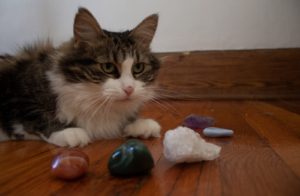A look into pet reiki

A cat next to reiki crystals. Photo by Matt Flood.
Dogs, cats and many other animals share a variety of problems such as chronic pain, illness and anxiety. The conventional option to most of these problems is simple: take your pet to the vet. However some people think an alternative form of treatment may work just as well, or better, for their pets.
Reiki as it is known today, is a holistic medicinal practice originating from Japan, and has been in practice since 1922. The word reiki is a combination of two Japanese words: “Rei” meaning spirit or soul, and “ki” meaning life-force energy or vital energy. While the validity of reiki has been challenged and many are skeptical, it has not stopped practitioners from applying their technique to animals.
Caitlyn Lloyd, a 30-year-old animal reiki practitioner, works on pets.
Her reiki sessions are held in the homes of the pets she is treating. For Lloyd, the treatment process begins before she arrives.
“As I’m traveling to a home, I will go into a meditation of sorts that is taken to while driving,” said Lloyd. “I imagine myself connected with the earth. And I imagine myself connected to the sky above… and with that, I ask for reiki.”
Within this meditation Lloyd asks for permission from who she is treating. But with animals,, Lloyd can only be sure permission has been given when she arrives.
“Animals are so innate in their intuition, right, they’re so connected. So they actually recognize energy from the get-go,” said Lloyd.
Lloyd claims animals she works with display openness through their body language and behaviour upon picking up on her ‘healing energy’. For example, an aggressive and hostile cat who often attacks its owner and guests, rolls over and exposes its belly to her—a known sign of trust or love which is out of character for that cat.
Once she feels permission has been granted, the real session starts.
With people, it is clear the reiki practitioner is in control of the situation. However, with animals being relatively uncontrollable, the individual in charge is the recipient, not the reiki practitioner.
“They could be in a closet, they could be under the stairs, they can be lounging on the couch,” said Lloyd. “And the thing is, is that I go with what they want. So If I have to sit in a closet, if I have to sit behind a couch, have to sit on the floor, that’s what I’m going to do. I’m going to do what they need.”
Now that the stage is set, the healing energy must be applied. With the animal in control, Lloyd takes a different approach when bringing in energy. Rather than applying it directly, she claims to fill the room with ambient healing energy which the animals are free to interact with as they wish.
“They may not be right in my space, they may be three feet from me, they may be 10 feet from me. They can still receive us,” said Lloyd.
While Lloyd claims her work has helped animals deal with aggression issues, separation anxiety and more, many remain skeptical.
Theresa Warriner, 26, graduated from the University of Windsor with a masters in biology and says her mother has attempted to use energy healing on her cats.
“I look at it as her way of sending love to my cats,” said Warriner. “She doesn’t always tell me when she does it, I view kind of like how grandmas will sneak cookies to the grandchildren. My mum just sends positive energy and love to my girls.”
Whether or not the claims about reiki are true, people are continuing to look into the technique and try it for themselves as the alternative medicine market is projected to grow.


